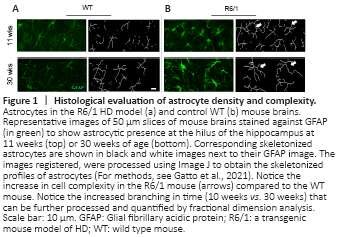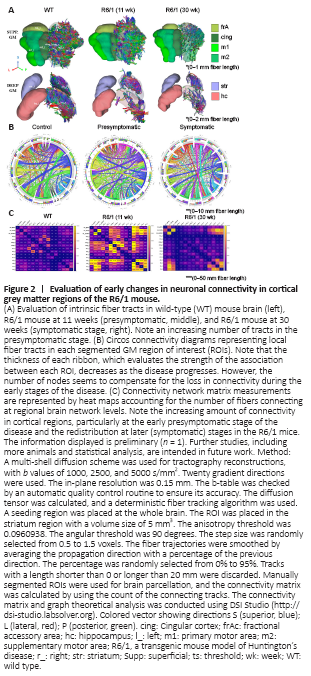神经退行性病
-
Figure 1|Histological evaluation of astrocyte density and complexity.

A hallmark of HD neuronal pathology is the presence of intracellular mHTT aggregates. In addition to the aggregates found in neurons, numerous studies have shown that inclusions are also present in cortical and striatal astrocytes (Khakh et al., 2017). And the presence of mHTT specifically in astrocytes and astrocyte dysfunction has been suggested to directly contribute to HD pathology (Khakh et al., 2017). The evaluation of the dynamic distribution of neuronal and glial populations has traditionally relied on immunohistochemistry. Histochemical methods have become one of the neuropathological gold standards in the evaluation of molecular and biochemical markers in NDDs. With this type of evaluation, we have shown the increase of astrocyte levels in the R6/1 mouse model at initial stages, striking in certain regions such as the hippocampus, as depicted in (Figure 1A) particularly associated with cognitive decline (Harris et al., 2019). On a cell level, critical structural properties can be further assessed by histomorphometry methods. As such, the use of qualitative-driven imaging techniques based on the level of cellular complexity (skeletonization and fractal dimension) can result in a richer evaluation of pathological features of NDDs. In that regard, our studies have shown that changes in cellular complexity add a significant level of microstructural information in HD. As an example, we described that astrocytic cells with elaborate branching processes (as assessed by their corresponding skeletonized structures, Figure 1B) had large fractal dimensions, particularly in complex deep grey matter (GM) structures, and revealed changes in branching complexity through time in HD mouse models (Gatto et al., 2021).
Figure 2|Evaluation of early changes in neuronal connectivity in cortical grey matter regions of the R6/1 mouse.

Genetic defects determine a progressive failure of the cellular structural integrity and potentially trigger brain connectivity failure in the context of HD. The inflammatory response could determine, partly, the loss of axonal connectivity. In particular, astrocytes also promote synapse formation, influence synapse stability, and help refine neural connectivity; neuronal structural plasticity and spine dynamics are also regulated by astrocytes (Fields et al., 2015). The tractography analysis of superficial and deep grey matter (GM) structures in the R6/1 brain revealed a pattern of local and broader alterations of connectivity (Figure 2A). Starting in early presymptomatic stages, a progressive and intrinsic reduction of connectivity within GM structures (1–2 mm fiber length) seems to be the scenario of complex microstructural changes, analyzed traditionally in WM fibers (up to 30 mm). Interestingly, our connectomics analysis seems to evidence the importance of considering not only the overall number of axons in these interconnecting fascicles (strength of these connections) but also the number of interconnecting nodes, which showed a marked increase in our studies (Figure 2B). Such topographic rearrangements in susceptible regions of the HD brain (particularly noticed in larger WM fibers of up to 50 mm) showed changes in the number and redistribution of such connections during the presymptomatic and symptomatic stages of the disease (Figure 2C). Altogether, the integration of these imaging results not only point towards the dynamic adaptative nature (neuroregenerative and neuroplastic properties) of the brain but also give new hints to characterize this phenomenon and its potential clinical application using early neuroimaging biomarkers. As an example, combined biochemical and imaging studies such as MRI spectroscopy have shown chemical changes in the basal ganglia regions (putamen) of HD patients, thus, potentially useful in clinical practice (Padowski et al., 2014; van den Bogaard et al., 2014).